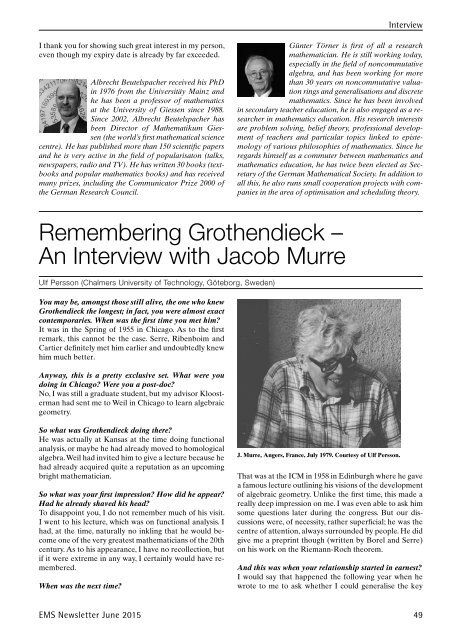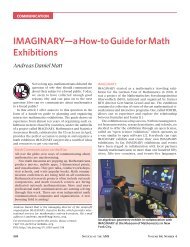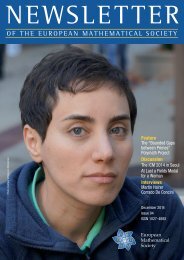Interviewvery exact sketching. What I am interested in is whetheryou actually think in images or in mathematical formulas?T: You also sketch it right? But you have never publishedthose sketches in your works, have you?Well, the bin is part of a mathematician’s work equipment,right?T: Yes, that’s true.No, I mean I haven’t burnt all of my bridges; I have evenpointed them out in my works. However, I don’t believethat I think in images so much. I think I see the connectionswith regards to mathematical formulas more clearlyand I always look out for my students to have masteredthe syntax as well.B: Are you talking about mathematical syntax or alsolinguistic syntax?Linguistic syntax is taken for granted, I believe. I was referringto mathematical syntax. You can’t get the analyststo give up talking of when referring to the circle, butnever mind. As long as you know how they mean it… Aslong as you know how it’s done properly, you can behavebadly.T: Learning mathematics surely is active mathematicalengagement, as Freudenthal put it.I always say that learning mathematical formulas byheart is nonsense; you should learn them by means ofapplication. If you just use them often enough, you willeventually use them automatically. I have never memorisedthe formulas for solving quadratic equations and Ihave done so on purpose. I always do the quadratic completionmyself; that’s a lot easier.T: Regarding parabolas, I have never used the root formulafor cubic functions either.Yes, Cardano. There’s no sense in that; you’re not supposedto learn something like that by heart. In case youneed it, you should try and find out for yourself how tosolve the cubic function. That’s better. So, in that respect,I’m against learning by heart. I have never learnt anythingby heart in mathematics myself. But I have alwaysworked with it and, in time, you just do so automatically.That’s the way things go in everyday life as well.T: So you achieve understanding whilst working andapplying them?That’s when you have to learn it. Strangely, the use ofbrackets is regarded as something very typical for mathematics.I remember my neighbour in Tübingen, an elderlydermatologist, who used to greet me by saying: ‘So,do you want to open and close your brackets again?’That was the one thing he recalled from mathematics,even though there are styles of writing without brackets.You don’t even need variables – Bourbaki pointedthis out in his book on foundations – if you connect thepositions in which the same variables occur by means ofan arc. You simply need to insert the same element in therespective positions. I have always fought against regardinggeneral numbers as a special kind of number. Fortunately,it seems to have become practice to understandthe term with spaces.From my fellow student Paul Lorenzen, I learnt to beaware of mathematical syntax. I followed his operationaljustification of mathematics also in a very intense correspondence.We met, as I mentioned earlier, in one ofHasse’s seminars.10 Mathematics in society and the perspectiveof mathematicsB: Maybe we can talk about another aspect which couldbe characterised as the social standing of mathematics.Do you think that there have been changes during thenearly 100 years of your life?Well, you, Mr Beutelsbacher, have clearly made a contributionto these changes.T: If we look into the future, how would you judge theperspective of mathematics?That’s difficult, indeed. As Hellmuth Kneser repliedaround 1950 when asked what he thought about mathematicsin the 20th century: ‘That’s very difficult, especiallyduring the second part.’ Therefore, I don’t dare give aprediction. Even though I’m still following the literature,I am too branched off the topic.B: If you look back on the mathematics of the 20th centuryand maybe compare it to the mathematics of the19th century, which was also full of great mathematics,do you think they are equal in rank or is 20th centurymathematics better or did they focus more on the substantialtopics during the 19th century?You mean in comparison?B: Exactly. Has mathematics changed to the same extentthat we can observe for the changes during the 19thcentury?Yes of course, but maybe in a different direction. On theone hand, there is a strong tendency for formalisation,initiated by the basic research of Hilbert-Bernays, and Ihave also contributed my share. With some gratification,I note that my colleagues from Münster thought I haddone quite a good job there.I was especially concerned with bringing this into mathematics.Perhaps it’s not that good because it keeps awaythe fantasy but I intended to do it as precisely as possible.So this is one of the main characteristics of the 20th century.I don’t think it was as central to mathematics duringthe 19th century. As Freudenthal once maliciously toldsomeone who had pointed out a gap: ‘…and this is anaxiom!’ Freudenthal was always quite cutting.B: I should formulate the final word. We wish you furtherpleasure with our field within society, wisdom forour professional group and luck for sound health andcontinuous mental clarity. We personally look forwardto celebrating a very special birthday colloquium withyou…48 EMS Newsletter June <strong>2015</strong>
InterviewI thank you for showing such great interest in my person,even though my expiry date is already by far exceeded.Albrecht Beutelspacher received his PhDin 1976 from the Universitäy Mainz andhe has been a professor of mathematicsat the University of Giessen since 1988.Since 2002, Albrecht Beutelspacher hasbeen Director of Mathematikum Giessen(the world’s first mathematical sciencecentre). He has published more than 150 scientific papersand he is very active in the field of popularisaton (talks,newspapers, radio and TV). He has written 30 books (textbooksand popular mathematics books) and has receivedmany prizes, including the Communicator Prize 2000 ofthe German Research Council.Günter Törner is first of all a researchmathematician. He is still working today,especially in the field of noncommutativealgebra, and has been working for morethan 30 years on noncommutative valuationrings and generalisations and discretemathematics. Since he has been involvedin secondary teacher education, he is also engaged as a researcherin mathematics education. His research interestsare problem solving, belief theory, professional developmentof teachers and particular topics linked to epistemologyof various philosophies of mathematics. Since heregards himself as a commuter between mathematics andmathematics education, he has twice been elected as Secretaryof the German Mathematical Society. In addition toall this, he also runs small cooperation projects with companiesin the area of optimisation and scheduling theory.Remembering Grothendieck –An Interview with Jacob MurreUlf Persson (Chalmers University of Technology, Göteborg, Sweden)You may be, amongst those still alive, the one who knewGrothendieck the longest; in fact, you were almost exactcontemporaries. When was the first time you met him?It was in the Spring of 1955 in Chicago. As to the firstremark, this cannot be the case. Serre, Ribenboim andCartier definitely met him earlier and undoubtedly knewhim much better.Anyway, this is a pretty exclusive set. What were youdoing in Chicago? Were you a post-doc?No, I was still a graduate student, but my advisor Kloostermanhad sent me to Weil in Chicago to learn algebraicgeometry.So what was Grothendieck doing there?He was actually at Kansas at the time doing functionalanalysis, or maybe he had already moved to homologicalalgebra. Weil had invited him to give a lecture because hehad already acquired quite a reputation as an upcomingbright mathematician.So what was your first impression? How did he appear?Had he already shaved his head?To disappoint you, I do not remember much of his visit.I went to his lecture, which was on functional analysis. Ihad, at the time, naturally no inkling that he would becomeone of the very greatest mathematicians of the 20thcentury. As to his appearance, I have no recollection, butif it were extreme in any way, I certainly would have remembered.When was the next time?J. Murre, Angers, France, July 1979. Courtesy of Ulf Persson.That was at the ICM in 1958 in Edinburgh where he gavea famous lecture outlining his visions of the developmentof algebraic geometry. Unlike the first time, this made areally deep impression on me. I was even able to ask himsome questions later during the congress. But our discussionswere, of necessity, rather superficial; he was thecentre of attention, always surrounded by people. He didgive me a preprint though (written by Borel and Serre)on his work on the Riemann-Roch theorem.And this was when your relationship started in earnest?I would say that happened the following year when hewrote to me to ask whether I could generalise the keyEMS Newsletter June <strong>2015</strong> 49






